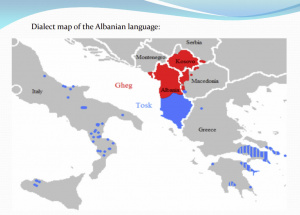Language/Tosk-albanian/Grammar/Nouns-and-Gender
| Next Lesson — Verbs and Present Tense ▶️ |
Welcome to our lesson on Nouns and Gender in Tosk Albanian! This topic is essential for any beginner looking to grasp the fundamentals of the language. Nouns are the building blocks of our communication, and understanding their gender will help you form correct sentences and express yourself accurately.
In Tosk Albanian, like in many other languages, nouns can be classified into different genders—masculine, feminine, and neuter. This classification affects how nouns interact with verbs, adjectives, and articles, making it a crucial concept to master.
In this lesson, we will explore the following topics:
Overview of Nouns
What is a Noun?
A noun is a word that denotes a person, place, thing, or idea. In Tosk Albanian, nouns are categorized based on their gender, which influences how they are used in sentences.
Types of Nouns
- Common Nouns: General names for a person, place, or thing (e.g., libër - book).
- Proper Nouns: Specific names (e.g., Tiranë - Tirana).
- Collective Nouns: Names that refer to a group (e.g., shkollë - school).
Understanding Gender in Tosk Albanian
Gender Overview
Nouns in Tosk Albanian are classified into three genders:
- Masculine: Typically ends in consonants or specific vowel sounds.
- Feminine: Often ends in -a or -e.
- Neuter: Usually ends in -o or -e.
Importance of Gender
The gender of a noun affects:
- The form of adjectives that describe it.
- The definite articles used with it.
- The verb forms in some contexts.
Examples of Nouns by Gender
To illustrate how nouns are categorized, let’s look at some examples:
| Tosk Albanian | Pronunciation | English |
|---|---|---|
| djalë | [dʒalɛ] | boy |
| vajzë | [vaizə] | girl |
| libër | [libər] | book |
| shtëpi | [ʃtəpi] | house |
| kafshë | [kafʃə] | animal |
| fëmijë | [fəmiːjə] | child |
| mjek | [mjɛk] | doctor |
| shok | [ʃok] | friend |
| kënd | [kənd] | corner |
| kafaz | [kafaːz] | cage |
| trëndafil | [trɛndaːfil] | rose |
| mollë | [mɔlːə] | apple |
| dritë | [dritə] | light |
| emër | [ɛmər] | name |
| qytet | [qytɛt] | city |
| ushqim | [uʃqim] | food |
| llambë | [lambə] | lamp |
| pyll | [pɪl] | forest |
| shtatë | [ʃtaːt] | seven |
| guri | [ɡuɾi] | stone |
| këndvështrim | [kɛndvəʃtɾim] | perspective |
Rules for Determining Gender
Masculine Nouns
- Generally, nouns ending in consonants are masculine.
- Example: mjek (doctor), djalë (boy).
Feminine Nouns
- Nouns ending in -a or -e are typically feminine.
- Example: vajzë (girl), mollë (apple).
Neuter Nouns
- Nouns that end in -o or -e can often be neuter.
- Example: shtatë (seven), kënd (corner).
Exceptions
Like any language, there are exceptions to these rules. For instance, some masculine nouns may end in -ë or -i (e.g., shok - friend).
Practice Exercises
Now that we've explored nouns and their gender in Tosk Albanian, it's time to put your knowledge to the test! Here are some exercises to help you practice:
Exercise 1: Identify the Gender
Determine the gender of the following nouns:
1. mollë
2. kafshë
3. djalë
4. shtatë
5. vajzë
Solutions:
1. Feminine
2. Feminine
3. Masculine
4. Neuter
5. Feminine
Exercise 2: Fill in the Blanks
Fill in the blanks with the correct form of the noun based on gender.
1. _______ (djalë) i ri është këtu. (the boy)
2. _______ (vajzë) është e bukur. (the girl)
3. _______ (libër) është interesant. (the book)
Solutions:
1. Djaloshi
2. Vajza
3. Libri
Exercise 3: Match the Noun with its Gender
Match the following nouns to their correct genders:
1. mjek
2. shkollë
3. trëndafil
4. ushqim
5. kafaz
Solution:
- Masculine: 1, 4
- Feminine: 2, 3
- Neuter: 5
Exercise 4: Gender Transformation
Transform the following nouns from masculine to feminine:
1. djalë
2. mjek
Solutions:
1. vajzë
2. mjeke
Exercise 5: Create Sentences
Use the following nouns in a sentence, ensuring you agree on gender:
1. kafshë
2. dritë
Example Sentences:
1. Kafsha është e bukur. (The animal is beautiful.)
2. Drita është e fortë. (The light is strong.)
Exercise 6: Gender Identification in Context
Read the sentences below and identify the gender of the underlined nouns:
1. Djalë i ri është duke luajtur.
2. Mollë është e shijshme.
Solutions:
1. Masculine
2. Feminine
Exercise 7: Noun Classification
Classify the following nouns as masculine, feminine, or neuter:
1. qytet
2. llambë
3. këndvështrim
Solutions:
1. Neuter
2. Feminine
3. Masculine
Exercise 8: Article Agreement
Fill in the correct definite article based on the gender of the nouns provided:
1. _______ (djalë)
2. _______ (vajzë)
3. _______ (libër)
Solutions:
1. Djaloshi
2. Vajza
3. Libri
Exercise 9: Translate the Nouns
Translate the following English nouns to Tosk Albanian, ensuring you identify their gender:
1. doctor
2. apple
3. friend
Solutions:
1. mjek (masculine)
2. mollë (feminine)
3. shok (masculine)
Exercise 10: Create Your Own Nouns
Think of five nouns in English and translate them into Tosk Albanian, identifying their gender.
Example:
1. house - shtëpi (feminine)
Conclusion
Understanding nouns and their gender is a crucial step in learning Tosk Albanian. Mastering this concept will pave the way for your future studies in grammar, sentence structure, and vocabulary. Remember, practice makes perfect! Keep referring back to this guide as you continue your language journey.
Here is an example below (use relevant title, keywords and description values)
Other Lessons
- Verbs and Present Tense
- Adverbs of Manner
- Future Tense
- 0 to A1 Course
- Conditional Mood
- Gender
- Adjectives and Nouns Agreement
- To Be and To Have
- Give your Opinion
- Question Words
| Next Lesson — Verbs and Present Tense ▶️ |

